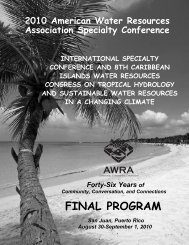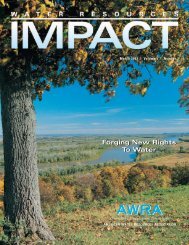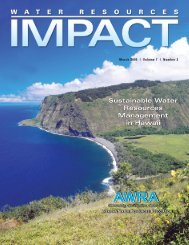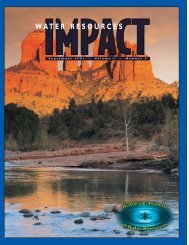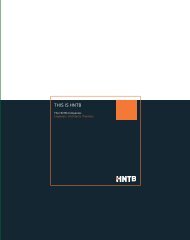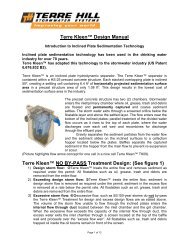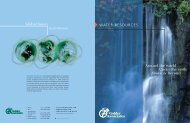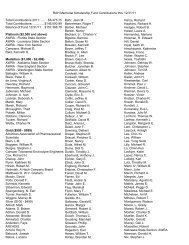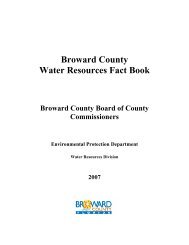Groundwater II - Aquifer Storage and Recovery (ASR)
Groundwater II - Aquifer Storage and Recovery (ASR)
Groundwater II - Aquifer Storage and Recovery (ASR)
Create successful ePaper yourself
Turn your PDF publications into a flip-book with our unique Google optimized e-Paper software.
American Water Resources Association<br />
2013 ANNUAL WATER RESOURCES CONFERENCE<br />
November 4‐7, 2013<br />
Portl<strong>and</strong>, OR<br />
Wednesday, Nov. 6<br />
8:30 AM – 10:00 AM<br />
SESSION 46: <strong>Groundwater</strong> <strong>II</strong>. <strong>Aquifer</strong> <strong>Storage</strong> <strong>and</strong> <strong>Recovery</strong> (<strong>ASR</strong>)<br />
A Desktop Suitability Assessment of <strong>Aquifer</strong> <strong>Storage</strong> <strong>and</strong> <strong>Recovery</strong> (<strong>ASR</strong>) in Washington State ‐ Maria<br />
Gibson, Oregon State University, Eugene, OR (co‐author: M. E. Campana)<br />
In Washington, the Cascade Range snowpack is the State's largest natural freshwater reservoir. As<br />
climate deviates from current conditions, <strong>and</strong> type <strong>and</strong> timing of precipitation change, opportunities to<br />
capture <strong>and</strong> store surplus runoff for later use will increase. Since surface storage methods have a<br />
number of drawbacks ‐ cost, environmental issues, l<strong>and</strong> availability, <strong>and</strong> evaporative losses, to name a<br />
few ‐ alternative storage methods are preferable. <strong>Aquifer</strong> <strong>Storage</strong> <strong>and</strong> <strong>Recovery</strong> (<strong>ASR</strong>) is an underground<br />
storage option used to supplement freshwater reserves. With the ability to capture <strong>and</strong> inject water<br />
underground during high flow periods for later use, <strong>ASR</strong> is a viable option to mitigate climatic changes<br />
<strong>and</strong> augment Washington's freshwater supply. To estimate <strong>ASR</strong> suitability, the assessment of factors<br />
such as infrastructure considerations, aquifer characteristics, <strong>and</strong> regulatory requirements offers insight<br />
into the potential for statewide <strong>ASR</strong> expansion before conducting expensive on‐site investigations. To<br />
evaluate <strong>ASR</strong> feasibility throughout Washington, a desktop suitability assessment, using a modified <strong>ASR</strong><br />
metric <strong>and</strong> a site suitability assessment, was applied to over 280 locations within Washington's 62 Water<br />
Resource Inventory Areas (WRIA). The modified <strong>ASR</strong> metric, which is a ratio of the estimated desired<br />
volumetric injection rate to the rate at which an aquifer can accept the injected water, indicates 24%<br />
<strong>and</strong> 29% of sites are marginally suitable <strong>and</strong> suitable for <strong>ASR</strong>, respectively, thereby adding a combined<br />
potential storage volume of at least 85,000 acre‐feet per year to Washington's supply. Additionally, of<br />
this volume, about 50,000 acre‐feet per year of potential storage was realized for WRIAs on the east<br />
side of the Cascades, which satisfies approximately 17% of predicted 2030 municipal <strong>and</strong> industrial<br />
consumptive use estimates. The site suitability assessment, which integrates regulatory, hydrogeologic,<br />
<strong>and</strong> infrastructure factors to produce a percentage of ideal conditions suitable for <strong>ASR</strong>, indicates 51% of<br />
locations have between 40% to 60% ideal conditions. Furthermore, 32% of marginally suitable <strong>and</strong> 36%<br />
of suitable locations, based on the modified <strong>ASR</strong> metric, have greater than 60% ideal conditions suitable<br />
for <strong>ASR</strong>. This suggests great potential for <strong>ASR</strong> developments exist in Washington <strong>and</strong> could aid in<br />
satisfying current dem<strong>and</strong> <strong>and</strong> augmenting future water storage needs. Because of the limited data<br />
requirements, the technique can be used elsewhere to provide rapid estimates of <strong>ASR</strong> suitability. It<br />
should prove applicable to developed <strong>and</strong> developing regions alike.<br />
Regulatory Disparities of <strong>ASR</strong> Projects in the US: An Old Fashion Showdown in Texas, the Outlaw of<br />
Georgia, <strong>and</strong> the Big Cheese Gone South in Wisconsin ‐ Maria Gibson, Oregon State University, Eugene,<br />
OR<br />
<strong>Aquifer</strong> <strong>Storage</strong> <strong>and</strong> <strong>Recovery</strong> (<strong>ASR</strong>) projects in the United States are federally regulated by the U.S.<br />
Environmental Protection Agency's (EPA) Underground Injection Control Program. Although all states<br />
must enforce EPA st<strong>and</strong>ards, on a state level, policy on <strong>and</strong> regulation of <strong>ASR</strong> can extend beyond such<br />
regulations. Therefore, legal implementation of these projects can differ greatly by state, <strong>and</strong> in some
instances, on a local level, due to interstate water governing districts. To best emphasize these<br />
differences, case studies with respect to regulatory matters of <strong>ASR</strong> projects in Texas, Georgia, <strong>and</strong><br />
Wisconsin are presented.<br />
Preliminary Evaluation of <strong>Aquifer</strong> <strong>Storage</strong> <strong>and</strong> <strong>Recovery</strong>, Columbia River Off‐Channel <strong>Aquifer</strong> <strong>Storage</strong><br />
Project – James Miller, GeoEngineers, Inc., Redmond, WA (co‐authors: G. Gregory, J. Covert)<br />
The Washington State Department of Ecology is conducting a preliminary evaluation of the suitability of<br />
aquifer storage <strong>and</strong> recovery (<strong>ASR</strong>) at a potential project site in Douglas County, near the northwestern<br />
limits of the Columbia Plateau. If feasible, the project would utilize surface water from the Columbia<br />
River for off‐channel storage in aquifers of the Columbia River Basalt Group (CRBG). The study area is<br />
somewhat isolated topographically with relatively little local use of groundwater.<br />
Investigation components have included installation of one test well <strong>and</strong> five monitoring wells, downhole<br />
video <strong>and</strong> borehole geophysical logging, borehole rock analyses by X‐ray fluorescence (XRF),<br />
groundwater chemical analyses, <strong>and</strong> aquifer testing <strong>and</strong> analysis. Subsurface explorations have<br />
encountered a layered aquifer system consisting of four major hydrostratigraphic units. These include,<br />
from youngest to oldest: (1) Wanapum Basalt, (2) Vantage Interbed, (3) Gr<strong>and</strong>e Ronde Basalt, <strong>and</strong> (4)<br />
pre‐Miocene basement rocks. The thicknesses of the units that overlie the basement rocks generally<br />
increase toward the south. The Vantage Interbed in the study area is relatively thick <strong>and</strong> includes<br />
substantial amounts of clay. The Vantage represents a very effective aquitard, with piezometric water<br />
levels in the Gr<strong>and</strong>e Ronde Basalt generally about 25 feet lower than water levels in the overlying<br />
Wanapum Basalt. Natural recharge to the Gr<strong>and</strong>e Ronde is severely limited by the semi‐arid climate of<br />
the study area, combined with relative topographic isolation <strong>and</strong> the presence of the Vantage aquitard.<br />
The Gr<strong>and</strong>e Ronde was selected for aquifer testing because of its greater depth <strong>and</strong> its relative isolation<br />
from the shallower Wanapum unit. A test well was competed as an open‐hole boring through the entire<br />
thickness of the Gr<strong>and</strong>e Ronde Basalt (uncased section extending between the depths of 250 feet <strong>and</strong><br />
400 feet). Three monitoring wells were completed within the Gr<strong>and</strong>e Ronde aquifer at varying distances<br />
to the test well. One monitoring well was completed in the overlying Wanapum aquifer at the test well<br />
site. <strong>Aquifer</strong> testing included a step‐rate pumping test <strong>and</strong> a 72‐hour pumping test at a constant rate of<br />
250 gpm. The testing resulted in immediate piezometric responses in the Gr<strong>and</strong>e Ronde observation<br />
well located relatively close to the pumping well. However, no measurable drawdown was recorded for<br />
monitoring points within the Wanapum Basalt, or for observation wells in the Gr<strong>and</strong>e Ronde Basalt that<br />
were located at distance from the test well. Analysis of the aquifer testing data indicates a low‐tomoderate<br />
transmissivity <strong>and</strong> a relatively high storativity for the Gr<strong>and</strong>e Ronde unit in the vicinity of the<br />
test well. Interpretation of the testing data <strong>and</strong> groundwater gradients suggests that the Gr<strong>and</strong>e Ronde<br />
aquifer in the study area is compartmentalized with an unusually high storativity for a confined aquifer.<br />
Based on information obtained to date, the potential for <strong>ASR</strong> appears promising at this site, <strong>and</strong> further<br />
evaluation of project feasibility is warranted.<br />
Webster Well 1 <strong>Aquifer</strong> <strong>Storage</strong> <strong>and</strong> <strong>Recovery</strong> ‐ Amy Ewing, Daniel B. Stephens & Associates, Inc.,<br />
Albuquerque , NM (co‐authors: J. M. Stomp <strong>II</strong>I, K. Yuhas, A. Friedt )<br />
The Albuquerque Bernalillo County Water Utility Authority (Water Authority) is conducting an aquifer<br />
storage <strong>and</strong> recovery (<strong>ASR</strong>) project using existing production wells <strong>and</strong> treated San Juan‐Chama water<br />
diverted from the Rio Gr<strong>and</strong>e. The purpose of the project is to recharge the Santa Fe Group aquifer<br />
system of the Middle Rio Gr<strong>and</strong>e Basin <strong>and</strong> to recover the water for later use.
<strong>Groundwater</strong> from Webster Well 1 has an arsenic concentration well above the U.S. Environmental<br />
Protection Agency National Primary Drinking Water Regulation maximum contaminant level, <strong>and</strong> the<br />
well is currently offline. The Water Authority is implementing the Webster Well 1 recharge<br />
demonstration project to determine whether <strong>ASR</strong> project implementation will allow wells with high<br />
arsenic concentrations to be brought back online. Retrofits at Webster Well 1 are complete, <strong>and</strong> a brief<br />
water quality test was conducted in the spring of 2013. A longer demonstration project is being planned<br />
to begin in late 2013.<br />
The project includes initial <strong>and</strong> periodic water quality sampling, including daily arsenic sampling during<br />
extraction. This presentation discusses the effectiveness, based on the injection test project results, of<br />
using existing infrastructure for <strong>ASR</strong> in the Albuquerque basin.



